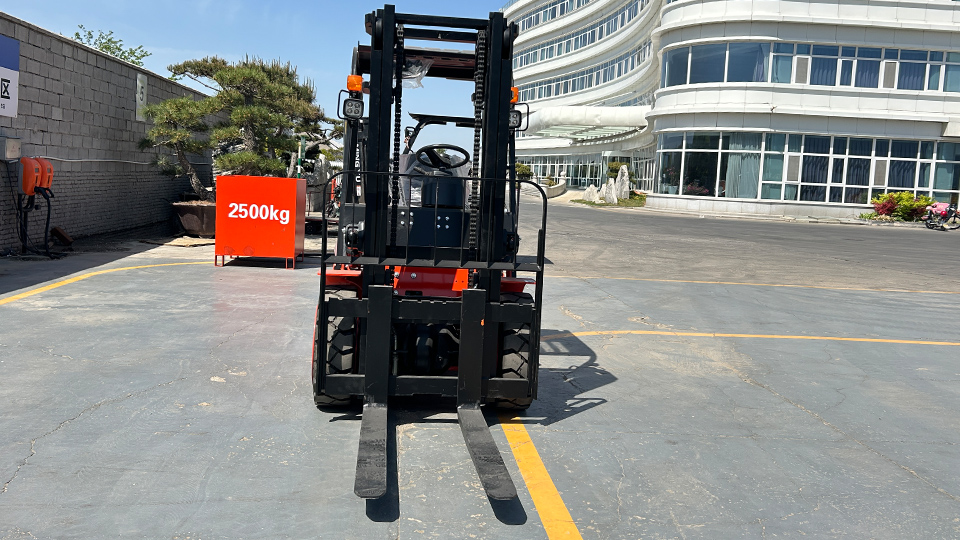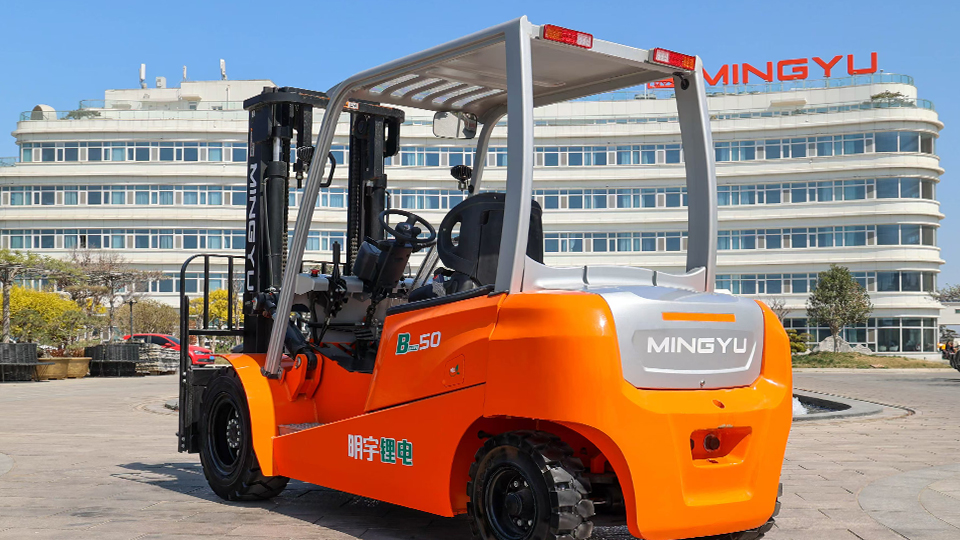
Introduction
The forklift, or powered industrial truck (PIT), is the indispensable workhorse of internal logistics. Engineered for lifting, stacking, and maneuvering loads within confined spaces like warehouses, distribution centers, and production facilities, its design prioritizes stability under load and tight-radius maneuverability over high-speed travel or road compliance. However, the realities of modern business—such as moving goods between adjacent factory buildings, crossing public access roads, or performing curbside loading/unloading—often necessitate the operation of these machines on public roadways.
I. Fundamental Design Disparities: Warehouse vs. Highway
A forklift's design is optimized for a low-speed, high-stress environment, making it inherently ill-suited for the dynamic, high-speed environment of a public road.
A. Steering and Stability System
Rear-Wheel Steering: The vast majority of forklifts use rear-wheel steering for enhanced maneuverability and a smaller turning radius. While excellent for navigating tight aisles, this design leads to highly unpredictable and unstable handling at higher road speeds. The machine pivots from the front axle, making quick corrections or slight turns feel exaggerated and drastically increasing the risk of lateral instability (rollover).
Stability Triangle: Unlike a standard automobile, which is highly stable due to a low center of gravity (CG) and four points of suspension, a counterbalanced forklift's stability is defined by the three-point stability triangle (the two front wheels and the center of the rear axle). Its inherent instability, especially when unladen and traveling at speed, makes it highly susceptible to tipping from dynamic forces like cornering or road irregularities.
Suspension and Tires: Most forklifts utilize solid or cushion tires and have little to no suspension, offering a harsh, low-traction ride on uneven road surfaces. This is compounded by the heavy counterweight, which transmits all road shock directly to the chassis and operator, exacerbating the risk of load instability and operator fatigue.
B. Braking Performance
Automotive braking systems are designed for high-speed deceleration. Forklift brakes are typically drum or wet-disc brakes, designed primarily for static holding and low-speed stops under heavy load within a warehouse environment.
Braking Distance: Given the machine's high mass (especially the counterweight) and lack of advanced anti-lock systems, the braking distance required to safely stop a forklift traveling at public road speeds (e.g., 40 km/h) is significantly greater than that of a standard road vehicle, posing a major collision risk.
Dynamic Load Shift: The sudden application of brakes causes a rapid forward shift of the CG. In a road vehicle, this is managed by the suspension. In a rigid forklift, it creates a massive forward tipping moment, which, while mitigated by the counterweight, increases the risk of the rear wheels lifting and loss of steering control.
C. Visibility and Operator Position
The operator's cab is generally positioned low, and the mast and carriage inherently obstruct the forward view, particularly when unladen (as the forks must be carried low, close to the ground, per safety regulations). Furthermore, standard forklifts lack the comprehensive array of mirrors and the elevated seating positions of commercial trucks, creating critical blind spots essential for safe road navigation.
II. The Regulatory Labyrinth: Achieving Legal Road Status

The legality of driving a forklift on a public road is not universal; it is governed by a strict, location-dependent framework that reclassifies the industrial vehicle as a road-going vehicle. This involves meeting the requirements of two distinct regulatory bodies: Occupational Safety/Health (e.g., OSHA, DGUV) and Road/Motor Vehicle Authority (e.g., DVLA, state DMVs).
A. The Distinction: "Workplace Equipment" vs. "Motor Vehicle"
The primary legal hurdle is the reclassification. A forklift operating solely on private property is subject only to workplace safety regulations. The moment it crosses a public right-of-way, it is legally deemed a "motor vehicle" and must comply with traffic, registration, and equipment laws.
B. Key Legal Requirements (Generalized)
While regulations vary widely by country and state, the following are near-universal requirements for road operation:
Registration and Licensing: The forklift must be registered with the relevant motor vehicle authority and display official license plates (or registration markers). This requires the vehicle to pass an initial inspection confirming its mechanical suitability for road use.
Taxation and Insurance: Road use typically mandates the payment of vehicle excise duty (road tax) and compulsory third-party liability insurance. Standard commercial liability insurance often does not cover accidents occurring on public roads.
Driver Qualifications: The operator must hold two certifications:
A valid Motor Vehicle Driver's License (usually Class C/B, or a specific agricultural/machinery class depending on vehicle mass and speed).
A valid Forklift Operator Certification (mandated by OSHA, DGUV, etc.), confirming their competence in operating the specific class of machine.
C. The UK "1000-Yard Rule" (A Case Study in Specificity)
The UK provides a specific technical benchmark:
Travel Less Than 1000 Yards (approx. 914 m): The forklift is often classed as a "Work Truck." While still requiring registration, tax, insurance, and a full driving license, the regulatory burden under the Road Vehicles (Construction and Use) Regulations is significantly lighter. Minimal modifications are required.
Travel Over 1000 Yards: The forklift must achieve full compliance with the Construction and Use Regulations, potentially requiring major structural and safety modifications and classifying the vehicle as a Heavy Goods Vehicle (HGV) if its gross mass exceeds 3,500 kg. This often makes long-distance road use practically unfeasible.
III. Mandatory Technical Modifications for Roadworthiness
To transition from an industrial truck to a legally compliant road vehicle, the forklift must undergo specific technical upgrades primarily focused on visibility, signaling, and safety.
A. Illumination and Signaling Systems
Road-legal forklifts must be equipped with the full range of mandated automotive lighting and signaling, which may include:
Forward Lighting: Dipped (low-beam) headlights and front position lights, ensuring adequate illumination and visibility to oncoming traffic.
Rear Lighting: Rear position (tail) lights, brake lights (stop lamps), and rear retro-reflectors.
Directional Signaling: Flashing amber direction indicators (turn signals) on both the front and rear, and often hazard warning signals.
Audible Warnings: A horn or similar acoustic warning device compliant with road noise standards.
B. Protrusion and Safety Requirements
The most distinctive feature of a forklift—the forks—presents a unique road hazard due to potential injury to pedestrians or other vehicles.
Fork Retraction/Guard: When traveling on a public road without a load, the forks must be fully lowered and tilted back. Crucially, the extreme forward protrusion must be mitigated. Regulations often require the forks to be covered with a brightly colored, high-visibility sleeve or guard to prevent accidental contact, or, in some jurisdictions, completely removed (if the task allows for it).
Mirrors: Compliance requires adequate rearward visibility, necessitating the installation of wide-angle exterior mirrors on both sides to compensate for the obstructed view from the cab and the limited utility of standard internal mirrors.

C. Speed Limitation and Marking
Most industrial forklifts are design-limited to a maximum speed of 20 km/h or 25 km/h. For road use, the machine must be marked with a speed-limit decal. Furthermore, if the design speed is below a certain threshold (e.g., 25 km/h in many EU nations), the machine may be exempt from certain construction regulations, simplifying the path to compliance but requiring the operator to adhere to minimum speed limits where mandated by traffic flow.
IV. Operational Safety and Best Practices
Even when fully road-legal, driving a forklift on a public road demands extreme caution due to its inherent operational limitations.
A. Travel Conditions
No Load Carriage (Generally): Forklifts are generally prohibited from traveling on public roads with a load, except for the immediate process of loading/unloading at the curbside or crossing a road with a very light, secured load under specific permit conditions. Traveling with an elevated load is strictly forbidden due to the extreme risk of longitudinal and lateral tipping.
Low Speed: Operators must travel at a speed that allows the vehicle to be brought to a safe stop under all conditions, usually well below the posted speed limit.
Forward Visibility Rule: Consistent with OSHA/Workplace Safety, if the lowered forks or the load obstructs the forward view, the operator must travel in reverse, using spotters or guides as necessary, especially on busy roads.
B. Dynamic Safety Concerns
Cornering: Turns must be executed slowly and smoothly, minimizing the centrifugal force that acts to shift the machine's CG outside the stability triangle and initiating a rollover.
Road Hazards: Forklifts are highly susceptible to instability caused by potholes, abrupt transitions, or uneven road shoulders. Operators must vigilantly avoid loose objects or surface irregularities.
Pedestrian and Traffic Interaction: Due to their slow speed, large turning radius, and intimidating profile, forklifts can disrupt traffic flow and confuse other motorists. The operator must strictly observe all road traffic regulations (traffic lights, right-of-way, etc.) and employ warning signals proactively.
Conclusion
Can forklifts be driven on public roads? Technically, yes, but only under severely restricted and legally mandated conditions. The operation is never "simple."
The feasibility is not an engineering question regarding the machine's absolute ability to move, but rather a regulatory and risk-management question. A forklift, by its very nature, is a highly unstable, slow, and sight-limited industrial tool. Converting it for legal and safe public road use requires a significant technical and administrative overhead, including:
Mandatory Mechanical Upgrades: Installation of full automotive lighting, signaling, and safety systems.
Administrative Compliance: Registration, road tax, specialized insurance, and adherence to specific distance or application restrictions (e.g., the 1000-yard rule).
Dual Certification: The operator must hold both a valid road driving license and a machine-specific operating certificate.
For any significant distance or frequent road travel, the technical, legal, and operational complexity overwhelmingly favors alternative solutions, such as transporting the forklift on a flatbed trailer. Forklifts belong primarily to the controlled environment of the workplace; their appearance on public roads should be considered an absolute last resort, executed with surgical precision and total compliance with both industrial safety and road traffic legislation.
Name: selena
Mobile:+86-13176910558
Tel:+86-0535-2090977
Whatsapp:8613181602336
Email:vip@mingyuforklift.com
Add:Xiaqiu Town, Laizhou, Yantai City, Shandong Province, China